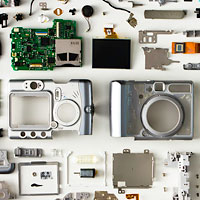Firmware Friday: Canon 1-series, Nikon P7700, Fuji X-series all get updates
posted Friday, May 31, 2013 at 3:40 PM EDT

In the last few days, new firmware has been released for no less than nine digital camera models, and with manufacturers working hard to provide reasons to shoot with a dedicated camera instead of your smartphone, the flood of updates -- both fixing bugs and in some cases adding new features -- isn't likely to let up any time soon.
New firmware is great if you own the camera in question, but it's not the most exciting thing in the world otherwise, so we've made an editorial decision here at Imaging Resource. With the exception of the most outstanding updates, we're going to start running a weekly roundup on what shall henceforth be known as "Firmware Friday". (We figure that the weekend is when most readers will have the spare time to install updates; the catchy alliteration is just a happy coincidence. That's our story, and we're sticking to it!)
For the first Firmware Friday update, we have news to report on several fronts:
Canon:
-
EOS-1D Mark III version 1.3.1
- Enables the center AF point to autofocus when the camera is used with the EF 200-400mm F4L USM Extender 1.4X lens and an Extender, whose combined maximum aperture is f/8.
-
EOS-1D Mark IV version 1.1.3
- Enables the center AF point to autofocus when the camera is used with the EF 200-400mm F4L USM Extender 1.4X lens and an Extender, whose combined maximum aperture is f/8.
- Fixes a phenomenon in which abnormal images may result when continuous shooting mode is enabled and the image size is set to “RAW” or “RAW+JPEG.
-
EOS-1Ds Mark III version 1.2.2
- Enables the center AF point to autofocus when the camera is used with the EF 200-400mm F4L USM Extender 1.4X lens and an Extender, whose combined maximum aperture is f/8.
-
EOS-1D C version 1.2.0
- Provides support for 25.00p (fps) video recording frame rate (PAL settings) at the camera’s maximum 4K resolution.
- A function to disable the Image size selection button has been added.
- Fixes a phenomenon in which a difference in exposure appears on every other shot when shooting continuously and the auto-lighting optimizer is turned on (on weak, standard or strong).
- Fixes a phenomenon in which video recorded onto an external recorder sometimes becomes two-layered if it has been recorded through HDMI output.
- The video frame rate now displays two additional decimal places, e.g. 24p -> 23.98p (fps)
- Fixes a phenomenon in which the on-screen guidance cannot be fully displayed when setting the maximum limit value for the “Auto ISO Range” option. (There was no problem with the Japanese language display.)
- Corrects errors in the Portuguese language menu. This cannot be displayed on units for Japan.
-
EOS-1D X version 1.2.4
- Improves the speed of the camera’s acquisition of focus when using a Canon Speedlite’s AF-assist beam.
- Reduces the time it takes to display the metering result on the LCD or Viewfinder when the meter has been activated.
- Fixes a phenomenon in which a “Caution 02” message is unnecessarily recorded in the camera status log.
- Fixes a phenomenon in which continuous shooting pauses when using a Canon Speedlite.
- Fixes a phenomenon, when the Canon GP-E1 is attached, in which the GPS device settings are reset to default settings when the camera has been powered off.
-
Wireless File Transmitter WFT-E7A version 1.0.4
- Fixes the rare issue of an error occurring during the transmission of images via Wireless LAN (FTP).
- The reliability of USB data transfer has been improved between the Canon EOS 5D Mark III running firmware version 1.2.1 and the Canon Wireless File Transmitter WFT-E7A running firmware 1.0.4. For optimal performance be sure to update both devices to the latest firmware version.
Fujifilm:
-
X-E1 version 1.05
- AF speed is improved when used with XF55-200mmF3.5-4.8 R LM OIS.
-
X-Pro1 version 2.04
- AF speed is improved when used with XF55-200mmF3.5-4.8 R LM OIS.
-
X100s version 1.03
- The phenomenon is fixed that in rare cases a grainy image like TV fuzz could appear on LCD under a certain shooting condition.
Nikon:
-
Coolpix P7700 version 1.2
- When shooting with shooting mode set to M (manual) with Flash, and the ISO sensitivity set to Auto, ISO 80-200, ISO 80-400, or ISO 80-800, ISO sensitivity was sometimes not locked at ISO 80 and a different ISO sensitivity was sometimes applied. This issue has been resolved.
Ricoh:
- G700SE version 1.30 (already covered earlier this week)
(Camera parts image courtesy of Kelly Hofer / Flickr; used under a Creative Commons CC-BY-2.0 license.)